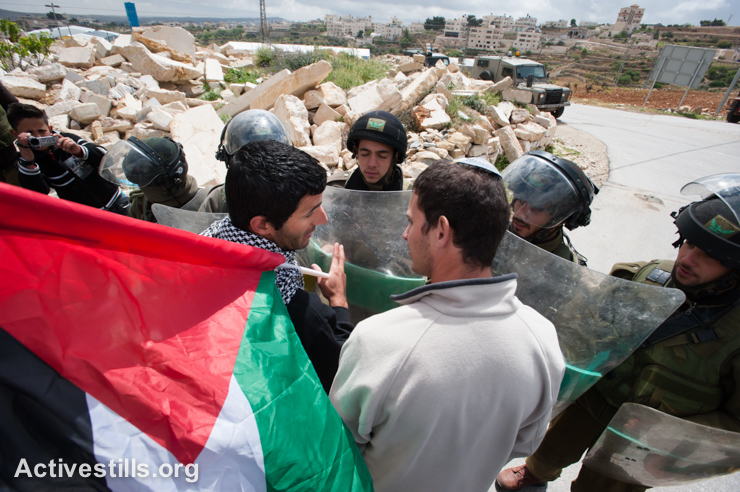The exposure of a popular ‘co-existence’ photo as a staged fabrication points to the need for better images of the path to a just peace.
Text and photo by: Ryan Rodrick Beiler/Activestills.org
A photograph intended to illustrate the peace process ended up being more accurate than intended. The now-iconic image showing a “Palestinian” and an Israeli boy walking arm in arm was a contrived set-up that anyone with experience in the region should have been able to spot as a fake.
The popular photo recently showed up in a tweet by Rihanna after she posted — and then quickly deleted — a tweet with the hashtag #FreePalestine during last summer’s Israeli offensive on Gaza.
Let’s pray for peace and a swift end to the Israeli-Palestinian conflict! Is there any hope?…. pic.twitter.com/jHD56KXkcu
— Rihanna (@rihanna) July 15, 2014
While it’s certainly true that many Palestinian and Israeli Jewish children are friends with each other, those familiar with local culture would know that only older men wear their keffiyeh scarf the way this little boy is shown. As it turns out, the Jewish boy wearing the kippah (yarmulke) wasn’t even religious — so even he’s fake.
As The Forward reports, the original photo was taken by American photographer Ricki Rosen for a cover story about the Oslo peace accords for the Canadian news magazine Maclean’s:
Rosen said that the magazine’s art director was so specific in what he wanted that he even drew her a picture — one boy in a yarmulke, the other in a keffiyeh shot from the back walking down a long road, which was supposed to symbolize the road to peace.
What makes this photo the more-perfect-than-intended allegory for the peace process is that it was the product of Western directors who orchestrated an image of peacemaking in which Israeli Jews went through the motions and Palestinians were excluded in virtually everything but appearance. Despite enthusiasm abroad for each new round of talks, few on the ground — either Palestinians or Israeli Jews — had much hope for their success, at least in recent years. Facts on the ground such as ongoing settlement construction had long subverted any real prospects for a two-state solution.
Yet the process goes on in fits and starts — and images like this endure and proliferate — because people in the West cling to the idea that if we all just came together as human beings, we could solve this thing. The problem with that fantasy is that it ignores the structures of Israeli oppression, in which one side holds virtually all of the power.
But perhaps more encouragingly, the allegory of this image continues to unfold in the sense that the truth behind it is finally coming out. Through social media, unnamed sources and candid comments in closed-door meetings, the real picture of Israeli colonization is slowly permeating global consciousness.
In that spirit, I offer an alternative image of the way to a just peace:

I know this photo won’t likely make the cover of Maclean’s or any other mainstream journal, but it’s a far more accurate image of genuine cooperation between Palestinians and Israeli Jews. Taken at the weekly demonstration against the Israeli Separation Wall in the West Bank town of al-Ma’sara, it shows an actual Palestinian activist wearing a keffiyeh and carrying a Palestinian flag. Next to him stands a kippah-wearing Israeli solidarity activist from the group Combatants for Peace. Both face a row of Israeli soldiers blocking the road so that the nonviolent demonstration cannot proceed.
(Bonus contrasting allegory: on the left side of the frame, a Palestinian child holds a B’Tselem video camera. The Israeli organization provides the camera; the boy documents his own reality and posts it on Facebook. Take that, Western media art directors!)
The activists engage in dialogue with each other and the soldier, but it is clear who holds the power in this image. There is no faking any saccharine symmetry of “can’t Palestinians and Jews just get along?” And no, there are not just “two sides” that need to “come together.” And no matter how much dialogue this Palestinian has with his Israeli friend by his side or the soldier blocking their path, the power dynamic of oppressor and oppressed remains. They’ve been having this demonstration every week for seven years. While the relationships on the ground are important, their ultimate goal is international pressure.
“I think in this peaceful demonstration, the important and the first thing is to make a change in the thinking of many people around the world,” says Mahmoud Al’aa Elddin, the Palestinian activist in the photo. “I have the hope and I have the power inside me to continue. But at the same time I don’t have power like the Israeli occupation. They have the power; they have all the guns. But for me, my weapons and my power are more and more the international people and the Israeli people who came and stand by my side.”
“Our problem is not with the Israeli people,” says Al’aa Elddin. “Israeli people come and they participate with us in our demonstration. The problem is with the Israeli army and the settlers who occupy the land, build the settlements and use violence against Palestinians.”
This image and Al’aa Elddin’s words illustrate why co-resistance by Israelis and internationals at all levels is needed before co-existence based on equality and justice can form the basis for a true and lasting peace.

